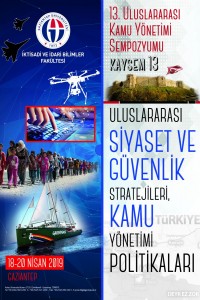Abstract
İnsanlık tarihi boyunca kitle ölümlerine sebebiyet veren salgın ve bulaşıcı hastalıklar ekonomik, siyasal ve demografik sonuçlarıyla daima küresel bir tehdit olmuştur. Görünmez ordular diye nitelendirilen ve yıkıcı etkileri olan bu hastalıkların dünya haritasını yeniden çizme hususundaki etkisi biyoterörizm kavramını ortaya çıkarmıştır. Biyolojik silah kullanma temelinde bir ülke veya toplum kesimine karşı en az savaş kadar yıkıcı etkileri olan biyoterör, ulusal ve küresel güvenlik adına oldukça önemli bir konudur. Konuyu hayati seviyede önemli kılan husus ise ulus yaşantılarını ve nihai olarak küresel yaşantıyı derinden etkileyebilme gücüdür. Biyoterörün bir millete veya devlete etkisi yalnızca hayat kayıplarıyla sınırlı kalmamaktadır. Bu tür saldırılar ulusların sosyo-ekonomik yaşantısını ve geleceğini de önemli ölçüde etkilemektedir. Ayrıca bu saldırıların genetiği değiştirilmiş bir virüs yoluyla kasıtlı olarak ortaya çıkarılabilmesi ve çok hızlı bir şekilde yayılabilmesi küresel tehdit boyutunu ortaya çıkarmaktadır. Biyoterör bu özelliklerinden ötürü nükleer terörden çok daha yıkıcı etkiler gösterebilmektedir. Herhangi bir nükleer terör saldırısı belirli sayıda insan kaybına sebebiyet verirken biyoterör ile insan kaybı hızla ve artarak devam etmektedir. Bu çarpıcı boyut konunun önemini, önceliğini ve alınması gereken önlemleri işaret etmektedir. Ayrıca bu tür salgın hastalıkların bulaşıcılığından ve kontrol altına alınmasının güç olmasından hareketle küresel güvenliği sağlama adına ciddi bir iş birliği gerekmektedir. Bu kapsamda ortaya çıkabilecek salgınları ve nedenlerini hızlı bir şekilde tespit edecek güçlendirilmiş bir küresel güvenlik iş birliği ile küresel halk sağlığı temel prensipleri dünyayı biyoterör tehdidine karşı savunmanın tek akılcı yolu olarak görülmektedir. Bu çalışmada ulusların salgın hastalıklar karşısındaki savunmasızlığı irdelenmiş olup önemli ölçüde artan biyoterör tehdidinin küresel güvenlik ve istihbarat çevrelerinde öncelik haline gelme süreci tartışılarak bazı önerilerde bulunulmuştur.
Keywords
References
- Cash, Richard ve Narasimhan, Vasant (2000). “Impediments to Global Surveillance of Infectious Diseases: Consequences of Open Reporting in A Global Economy”. Bulletin of the World Health Organization, 78: 1358-1367. Center for Health Security, (2001), “Hearing on the Threat of Bioterrorism and the Spread of Infectious Diseases”, http://www.centerforhealthsecurity.org/our-work/testimony-briefings/pdfs/2001-09-05-bt-and-spread-of-id.pdf, (Erişim Tarihi: 13.02.2019). Center for Strategic and International Studies, (2000), “Contagion and Conflict: Health As A Global Security Challenge”, https://csis-prod.s3.amazonaws.com/s3fs public/legacy_files/files/publication/000130_Moodie_ContagionConflict_Web.pdf, (Erişim Tarihi: 13.02.2019). Chyba, Christopher (2002). “Toward Biological Security”, Foreign Affairs, 81: 122–136. Congress, (2010), “Global Pathogen Surveillance Act of 2002”, https://www.congress.gov/bill/107th-congress/senate-bill/2487, (Erişim Tarihi: 13.02.2019). Director of National Intelligence, (2000), “The Global Infectious Disease Threat and Its Implications for the United States”, https://www.dni.gov/files/documents/infectiousdiseases_2000.pdf, (Erişim Tarihi: 13.02.2019). Dünya Sağlık Örgütü, (2001a), “Macroeconomics and Health: Investing in Health for Economic Development”, http://www1.worldbank.org/publicsector/pe/PEAMMarch2005/CMHReport.pdf, (Erişim Tarihi: 13.02.2019). Dünya Sağlık Örgütü, (2001b), “Global Health Security: Epidemic Alert and Response”, http://apps.who.int/medicinedocs/documents/s163536e/s16356e.pdf, (Erişim Tarihi: 13.02.2019). Dünya Sağlık Örgütü, (2002a), “Dengue Prevention and Control”, http://apps.who.int/gb/archive/pdf_files/WHA55/ea5519.pdf, (Erişim Tarihi: 13.02.2019). Dünya Sağlık Örgütü, (2002b), “Preparedness for the Deliberate Use of Biological Agents: A Rational Approach to the Unthinkable”, https://www.who.int/csr/resources/publications/deliberate/whacdscsreph200216.pdf?ua=1, (Erişim Tarihi: 13.02.2019). Dünya Sağlık Örgütü, (2003), “Global Defence Against the Infectious Disease Threat”, https://apps.who.int/iris/bitstream/handle/10665/42572/9241590297.pdf?sequence=1&isAllowed=y, (Erişim Tarihi: 13.02.2019). Dünya Sağlık Örgütü, (2018), “Managing Epidemics: Key Facts About Major Deadly Diseases”, https://www.who.int/emergencies/diseases/managing-epidemics/en/, (Erişim Tarihi: 18.07.2019). G7 Health Ministers, (2001), “G7 Health Ministers Meeting”, http://www.g8.utoronto.ca/health/ottawa2001.html, (Erişim Tarihi: 13.02.2019). GPHIN Canada, (2017), “About GPHIN”, https://gphin.canada.ca/cepr/aboutgphin-rmispenbref.jsp?language=en_CA, (Erişim Tarihi: 13.02.2019). Gubler, Duane (2001). “Human Arbovirus Infections Worldwide”. Annals of the New York Academy of Sciences, 951(1): 13-24. Health-Mil, (2013), “Global Emerging Infections Surveillance and Response”, https://www.health.mil/Military-Health-Topics/Health-Readiness/Armed-Forces-Health-Surveillance-Branch/Global-Emerging-Infections-Surveillance-and-Response, (Erişim Tarihi: 13.02.2019). Henderson, Donald (1999). “The Looming Threat of Bioterrorism”. Science, 283(5406): 1279-1282. Heymann, David (2003). “The Evolving Infectious Disease Threat: Implications for National and Global Security”. Journal of Human Development, 4(2): 191-207. Heymann, David ve Rodier, Guenael (2001). “Hot Spots in A Wired World: WHO Surveillance of Emerging And Re-emerging Infectious Diseases”. The Lancet Infectious Diseases, 1(5): 345-353. Kelley, Patrick (2000). “Transnational Contagion And Global Security”. Military Review, 80(3): 59-64. Knobler, Stacey & Mahmoud, Adel & Pray, Leslie (2002). Biological Threats and Terrorism. Assessing the Science and Response Capabilities. Washington: National Academy Press. Kuş Gribiyle Mücadele, (2017), “Türkiye'de Kuş Gribi”, http://www.kusgribi.gov.tr/TR/Genel/BelgeGoster.aspx?F6E10F8892433CFFAAF6AA849816B2EF3F93D97214554F97#ulkemizde, (Erişim Tarihi: 13.02.2019). Lederberg, Joshua (1996). “Infectious Disease - A Threat to Global Health and Security”. Jama, 276(5): 417-419. Medimagazin, (2009), “ABD'li Turistte Domuz Gribi Vakası”, https://www.medimagazin.com.tr/ilac-sanayi//tr-akdag-abdli-turistte-domuz-gribi-virusu-var-8-681-20261.html, (Erişim Tarihi: 13.02.2019). Oaks, Stanley & Shope, Robert & Lederberg, Joshua (1992). Emerging Infections: Microbial Threats to Health in the United States. Washington: National Academy Press. Ostergard Jr, Robert (2002). “Politics in the Hot Zone: AIDS and National Security in Africa”. Third World Quarterly, 23(2): 333-350. Tauxe, Robert & Mintz, Eric & Quick, Robert (1995). “Epidemic Cholera in the New World: Translating Field Epidemiology into New Prevention Strategies”. Emerging Infectious Diseases, 1(4): 141-146. UN Security Council, (2000), “Security Council Holds Debate on Impact Of Aids on Peace and Security in Africa”, https://www.un.org/press/en/2000/20000110.sc6781.doc.html, (Erişim Tarihi: 13.02.2019). UNAIDS, (2002), “Report on the Global HIV/AIDS Epidemic”, http://data.unaids.org/pub/report/2002/brglobal_aids_report_en_pdf_red_en.pdf, (Erişim Tarihi: 13.02.2019). Weekly Epidemiology Record, (2002), “Yellow Fever in Senegal”, https://www.who.int/wer/2002/werl8207.pdf, (Erişim Tarihi: 13.02.2019). Woolhouse, Mark (2002). “Population Biology of Emerging and Re-emerging Pathogens”. Trends in Microbiology, 10(10): 3-7.
Details
| Primary Language | Turkish |
|---|---|
| Journal Section | Article |
| Authors | |
| Publication Date | September 23, 2019 |
| Submission Date | June 15, 2019 |
| Published in Issue | Year 2019 ASSAM ULUSLARARASI HAKEMLİ DERGİ 13. ULUSLARARASI KAMU YÖNETİMİ SEMPOZYUMU BİLDİRİLERİ ÖZEL SAYISI |
ASSAM-UHAD is an internationally indexed peer-reviewed journal published in April and November.

